Past Bishops
The Catholic Diocese of Rockhampton has experienced a diverse leadership throughout its 131 year history. Beginning with an Italian as the first Bishop, the three following Bishops were Irishmen. They were then followed by five Australian born men.
Bishops of the Rockhampton Catholic Diocese
First Bishop of Rockhampton – Bishop John Cani (1882-1898)
Second Bishop of Rockhampton – Bishop Joseph Higgins (1899 -1905)
Third Bishop of Rockhampton – Bishop James Duhig (1905 -1912)
Fourth Bishop of Rockhampton – Bishop Joseph Shiel (1913 -1931)
Fifth Bishop of Rockhampton – Bishop Romuald Hayes (1932 -1945)
Sixth Bishop of Rockhampton – Bishop Andrew Tynan (1946 -1960)
Seventh Bishop of Rockhampton – Bishop Francis Rush (1961-1974)
Eigth Bishop of Rockhampton – Bishop Bernard Wallace (1974 -1990)
Ninth Bishop of Rockhampton – Bishop Brian Heenan (1991-2013)
First Bishop of Rockhampton – Bishop John Cani (1882-1898)
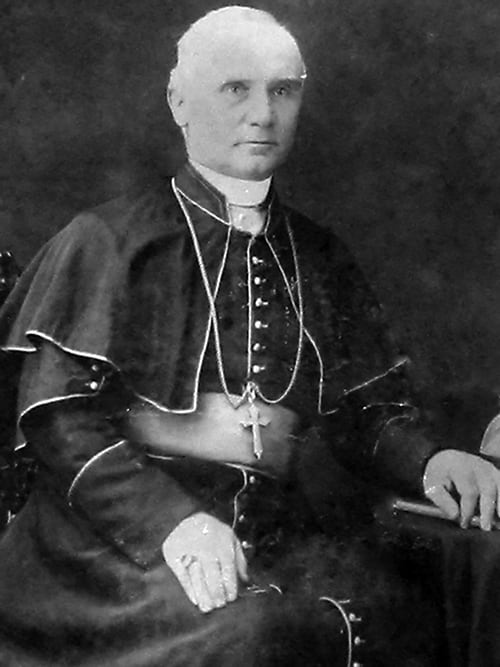 John Cani, the Italian priest who became the first Bishop of Rockhampton in 1882, was born in Castel Bolognese in the province of Emilia in northern Italy on December 22, 1834.
John Cani, the Italian priest who became the first Bishop of Rockhampton in 1882, was born in Castel Bolognese in the province of Emilia in northern Italy on December 22, 1834.
In 1856 he went to Rome as a student at the Roman Seminary where he gained a doctorate in divinity at age twenty-one. After ordination he turned his back on a possible career in Rome, joining the small missionary band which sailed from Gravesend England, on 8 December 1860 on the ship Donald McKay. Among those with whom Father Cani travelled to Queensland were, the state’s first Bishop, Irishman James O’Quinn (who later called himself Quinn) and Mother Vincent Whitty, also from Ireland, who established the Sisters of Mercy in Queensland. They arrived in Brisbane on 12 March 1861.
Father Cani’s first appointment was to Warwick, after which he was appointed Vicar General, Administrator and Secretary to Bishop Quinn. In 1877 he was appointed Pro-Vicar Apostolic in Cooktown and still preparing for the Papua New Guinea mission, when on 21 May 1882, he was consecrated Bishop at St Mary’s Cathedral, Sydney by Archbishop Roger Bede Vaughan and later installed at St Joseph’s Pro-Cathedral, Rockhampton on 11 June 1882.
Bishop Cani was a visionary and commenced on a great Cathedral in the bush. Unfortunately, various obstacles emerged, and hard as he tried, (as did several of his successors in the See of Rockhampton) he did not succeed in completing the task. The Cathedral of St Joseph in Rockhampton was finally completed by Bishop Bernard Wallace, the eighth Bishop of Rockhampton at a cost of more than $1 million in 1982, the centenary year of the Diocese. (The Papal Bulla actually established the Diocese in the dying stages of 1881, but the Centenary celebrations were held in 1982, one hundred years after the first Bishop, Bishop John Cani, was installed as Bishop of Rockhampton in 1882.)
Bishop Cani died on 3 March 1898 and was buried in the South Rockhampton Cemetery. Three years later his remains were removed to St Joseph’s Cathedral and an inscribed stone marks his last resting place.
Second Bishop of Rockhampton – Bishop Joseph Higgins (1899-1905)
 Joseph Higgins, the second Bishop of Rockhampton, was born in the Parish of Myvore, County of Westmeath, Ireland in 1838. He attended school at St Finian’s College at Navan, matriculating in January 1858. He studied for the priesthood at St Patrick’s College, Maynooth, where he won prizes in Theology and Church History.
Joseph Higgins, the second Bishop of Rockhampton, was born in the Parish of Myvore, County of Westmeath, Ireland in 1838. He attended school at St Finian’s College at Navan, matriculating in January 1858. He studied for the priesthood at St Patrick’s College, Maynooth, where he won prizes in Theology and Church History.
Joseph Higgins was ordained in May 1863. He worked as an assistant in the Parish of Tullamore for four years and returned to St Finian’s College as a professor, where he remained for seventeen years, then spent short terms as Parish Priest of Castlehover and Delvin in Ireland.
He was appointed Titular Bishop of Antifelle by Pope Leo XIII and was consecrated in Navan Church by the Archbishop of Dublin on 31 March 1889. A few months later, Bishop Higgins arrived in Sydney and was stationed at St Benedict’s for ten years, working with Cardinal Patrick Moran. He took a keen interest in Manly Seminary and education generally.
When Bishop Cani died, Bishop Higgins was appointed to the Diocese of Rockhampton, and took office on 4 May 1899. Bishop Higgins came to the Diocese with many advantages. He was an Irishman. He was already a Bishop of experience, having been appointed ten years earlier as an auxiliary to the Archbishop of Sydney, Cardinal Patrick Francis Moran.
Unfortunately, Central Queensland climate did not agree with him, and so for health reasons he was appointed as the first Bishop of Ballarat on 3 March 1905. He died on 16 September 1915 aged seventy-seven and is buried in St Patrick’s Cathedral, Ballarat.
Third Bishop of Rockhampton – Bishop James Duhig (1905-1912)
 James Duhig was born on 2 September 1871 at Kilila near Broadford, Limerick, Ireland – one of seven children. On the death of his father, John Duhig, the family moved to Middlesbrough, Yorkshire, England and then back to Ireland where they were evicted from their holding. They emigrated to Australia.
James Duhig was born on 2 September 1871 at Kilila near Broadford, Limerick, Ireland – one of seven children. On the death of his father, John Duhig, the family moved to Middlesbrough, Yorkshire, England and then back to Ireland where they were evicted from their holding. They emigrated to Australia.
After attending St Joseph’s College, Gregory Terrace, working for a while and returning to Terrace, he enrolled in the Irish College, Rome in 1891 and studied for the priesthood at the Urban University of Propaganda Fide. He was ordained a priest in 1896.
He was consecrated Bishop of Rockhampton in St Joseph’s Cathedral on 10 December 1905 by the then Coadjutor of Sydney, Archbishop Michael Kelly (who as Rector of the Irish College, Rome, had received the young James Duhig as a student fourteen years earlier) and by friends Bishop James Murray of Cairns and Bishop Patrick Vincent Dwyer of Maitland.
Only seven of James Duhig’s nearly sixty years as a Bishop were spent as Bishop of Rockhampton, but the Rockhampton Diocese became his first love. As Bishop of Rockhampton, James Duhig travelled by boat, train, coach and horseback (he was a good horseman) throughout the vast Diocese.
Bishop Duhig became Coadjutor Archbishop of Brisbane on 26th February 1912 and succeeded Archbishop Robert Dunne as Archbishop of Brisbane in 1917. During his nearly fifty year term he was involved in a massive building program (400 major buildings), received many honours (a knighthood in 1959) and earned a reputation as an educationist, book lover and patron of the arts.
When he died at ninety-three on 10 April 1965 as Archbishop of Brisbane, he was hailed as a great Australian.
Fourth Bishop of Rockhampton – Bishop Joseph Shiel (1913-1931)
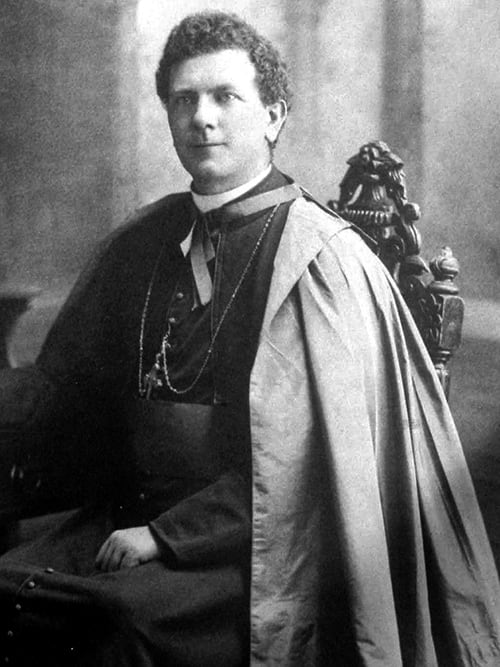 The fourth Bishop of Rockhampton, Joseph Shiel, originally came from Ireland to the Australian mission for five years. He was to devote the remainder of his life to the Australian Catholic Church.
The fourth Bishop of Rockhampton, Joseph Shiel, originally came from Ireland to the Australian mission for five years. He was to devote the remainder of his life to the Australian Catholic Church.
Bishop Shiel was born at Swainstown, Kilmessan, County Meath, Ireland on 17 February 1873.
Joseph Shiel began his education at the local National School. Having shown signs of a vocation to the priesthood, he did his secondary education at St Finian’s College and then at Navan, and in June 1892, won one of the few available places at the great Irish Seminary of Maynooth, St Patrick’s College, which primarily trains priests for the Irish dioceses. His links with Maynooth were many. He was ordained there on 19 June 1889 by the Archbishop of Dublin, William Walsh.
He served at Melbourne and Geelong and when his initial five years were up, obtained permission from his Bishop in Ireland to stay in Australia. Early in 1904 he accepted an invitation from the then Bishop of Rockhampton, Bishop Higgins, to go north. At first he was Administrator at Mt Morgan, then in February 1905, he was appointed Administrator of St Joseph’s Cathedral, Rockhampton. Bishop Higgins was appointed Bishop of Ballarat and in March 1906 Father Joseph Shiel joined him there. He later became Administrator of the Cathedral at Ballarat.
When holidaying in Ireland in 1912, Father Shiel was notified of his appointment as Bishop of Rockhampton in succession to James Duhig who had been made Coadjutor Archbishop of Brisbane. After his consecration at Maynooth by Archbishop Mannix, Bishop Shiel sailed from Dover, England on 15 February 1913 on the RMS Orana with Archbishop Mannix and Archbishop Mannix’s cousin, Dean Foley, afterwards Bishop of Ballarat.
His lifetime of service given to the Australian church was a busy one. When enthroned as Bishop in St Joseph’s Cathedral he was forty. When he died in Rockhampton in April 1931, he was fifty-eight.
Fifth Bishop of Rockhampton – Bishop Romuald Hayes (1932-1945)
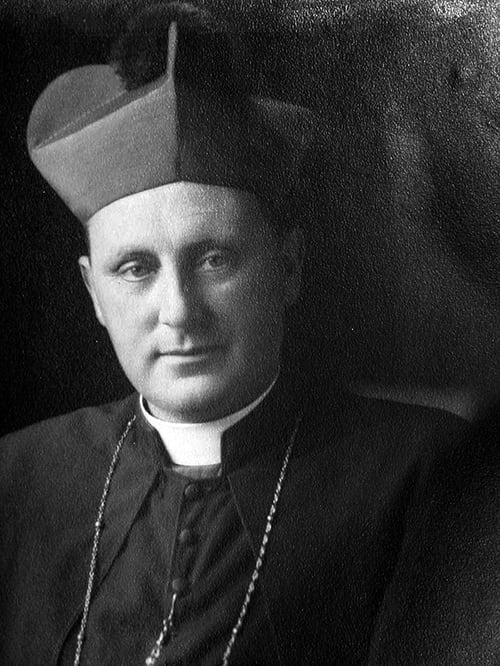 Bishop Romuald Hayes was born in Malvern, Victoria on 30 January 1892, his parents numbering amongst their distant relatives, the Irish Saint, Oliver Plunket, who was martyred at Tyburn, London. The family moved to Kyneton, where the future Bishop received his early education. His secondary education was at the Jesuit- conducted Xavier College, Kew, Melbourne, where he was an excellent student and sportsman and was appointed College Captain.
Bishop Romuald Hayes was born in Malvern, Victoria on 30 January 1892, his parents numbering amongst their distant relatives, the Irish Saint, Oliver Plunket, who was martyred at Tyburn, London. The family moved to Kyneton, where the future Bishop received his early education. His secondary education was at the Jesuit- conducted Xavier College, Kew, Melbourne, where he was an excellent student and sportsman and was appointed College Captain.
The young Romuald Hayes entered St Columba’s College, Springwood NSW in 1912 and went to St Patrick’s College Manly two years later. Selected by Archbishop TJ Carr of Melbourne to complete his Theology studies at Propaganda College, Rome, he was ordained on 10th August 1917 in the Church of St Apollinaris by Cardinal Pompilii.
Returning to Australia, Romuald Hayes spent two years as Assistant Priest at Northcote, Melbourne before volunteering to join the newly-founded Irish Columban Mission to China. After a brief visit to China, he returned to Essendon, the headquarters of the Columban Fathers in Australia to share in the work of developing the mission in Australia. In 1924 he became Director for the Mission, and was later Superior of the Columban Fathers in Australia.
Romuald Hayes was consecrated Bishop of Rockhampton by the Archbishop of Melbourne, the Most Rev Dr Daniel Mannix (as had been his predecessor, Bishop Shiel) on 3 April 1932 and enthroned in St Joseph’s Cathedral, Rockhampton by Archbishop Duhig of Brisbane on 24 April 1932.
Bishop Hayes took a keen interest in rural development with particular reference to irrigation.
His death on 25 October 1945 brought tributes from Australia and beyond, both religious and civic. Among messages received was a telegram from the President of the Irish Republic, Mr Éamon de Valera.
“He was the very soul of the rural movement in Central Queensland, because he was convinced that the land affords the best homes for the people”. Thus spoke Archbishop James Duhig of Brisbane at the obsequies of the Most Reverend Dr Romuald Plunket Hayes, fifth Bishop of Rockhampton.
Sixth Bishop of Rockhampton – Bishop Andrew Tynan (1946-1960)
 Bishop Andrew Tynan was appointed Bishop at thirty-eight (then the youngest member of the Australian hierarchy) on 21 March 1946 and died suddenly at fifty-two on 3 June 1960 in London.
Bishop Andrew Tynan was appointed Bishop at thirty-eight (then the youngest member of the Australian hierarchy) on 21 March 1946 and died suddenly at fifty-two on 3 June 1960 in London.
Bishop Tynan was born in Brisbane on 25 November 1907 and attended school at Gregory Terrace, Brisbane, St Patrick’s College, Goulburn, NSW and St Ignatius’ College, Riverview, Sydney. He studied for the priesthood at St Columba’s College, Springwood, NSW, St Patrick’s, Manly and the Irish College, Rome. He was ordained at St John Lateran Basilica, Rome on 21 March 1931 as a priest for the Archdiocese of Brisbane.
Returning to Australia at the end of the same year, his first appointment was as assistant at Ipswich. After five years he was transferred to the Parish of Hendra, and in 1937 joined the staff of St Stephen’s Cathedral in Brisbane. In 1938 in Brisbane, he became Director for the Propagation of the Faith and first diocesan chaplain of the Young Christian Workers movement. Andrew Gerard Tynan, sixth Bishop of Rockhampton, was firmly committed to the social teachings of the church, a promoter and defender of Catholic Action and a staunch supporter of the church’s role in society.
The first Queenslander to be appointed a Bishop, great progress was made during his fourteen years in Rockhampton. During Bishop Tynan’s episcopate, there was steady growth of the Diocese, new parishes were established and the numbers of priests and religious increased.
Bishop Tynan died in London on his way to Rome on an ad limina visit. His body was brought back to Rockhampton for burial.
Seventh Bishop of Rockhampton – Bishop Francis Rush (1961-1974)
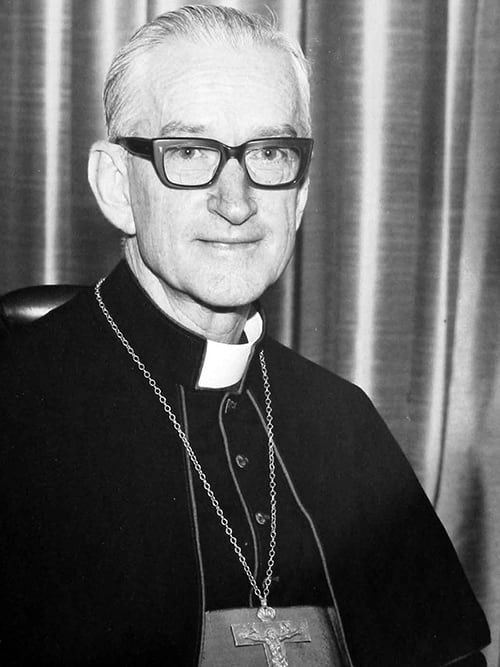 During his twelve years as Bishop of Rockhampton and later as Archbishop of Brisbane, Francis Roberts Rush strove to bring alive the doctrine that the people are the Church. His episcopate in Rockhampton Diocese, from 1961 to 1974, covered the period of the Second Vatican Council and its immediate aftermath. Bishop Rush was quick to implement the decisions of the council in his own Diocese, in particular, to ensure that the voices of all members of the Diocesan family were heard in Diocesan affairs.
During his twelve years as Bishop of Rockhampton and later as Archbishop of Brisbane, Francis Roberts Rush strove to bring alive the doctrine that the people are the Church. His episcopate in Rockhampton Diocese, from 1961 to 1974, covered the period of the Second Vatican Council and its immediate aftermath. Bishop Rush was quick to implement the decisions of the council in his own Diocese, in particular, to ensure that the voices of all members of the Diocesan family were heard in Diocesan affairs.
Francis Rush was born in Townsville in September 1916, the youngest of four sons of Irish-born parents (his father from Galway, his mother from Tralee, County Kerry). His schooling was with the Sisters of Mercy at Townsville and the Christian Brothers at Gregory Terrace, Brisbane and Mt Carmel College, Charters Towers.
He started his studies for the priesthood early in 1933 at St Columba’s College, Springwood, NSW. Towards the end of 1934 he went to Rome’s Propaganda College. He obtained the degrees of Bachelor of Philosophy and Licentiate of Sacred Theology.
With his brother, Father Ormond Rush, he was holidaying in Ireland when war broke out. He returned to Townsville and joined the staff of the Sacred Heart Cathedral, serving there until 1944. During the war he was one of a team of hard-working priests, under the direction of Bishop Hugh Ryan, who supplemented the work of the military chaplains in a Townsville crowded with servicemen.
His other appointments were Assistant Priest, Mundingburra (Townsville) 1944-50, Assistant Priest, Ingham 1950-54, Parish Priest, Abergowrie 1954-57, Parish Priest, Ingham 1957 until his appointment in 1961 as Bishop of Rockhampton.
On Wednesday morning, 8 February 1961, Bishop Rush was episcopally ordained in St Joseph’s Cathedral (he was the second Bishop of Rockhampton to be consecrated in his own Cathedral – James Duhig being the first) by the Apostolic Delegate, Archbishop de Furstenberg.
The establishment of the Diocesan Development Fund, the formation of a Priests’ Senate, the Diocesan Pastoral Council, Parish Councils, Parents and Friends Associations, the Education Council and the Central Education Fund were a few of his many achievements.
Bishop Rush’s appointment as Archbishop of Brisbane (in succession to Archbishop Patrick O’Donnell who was then retiring) was made on 6 March 1973. He retired in Brisbane in 1991 and died there in 2001.
Eighth Bishop of Rockhampton – Bishop Bernard Wallace (1974-1990)
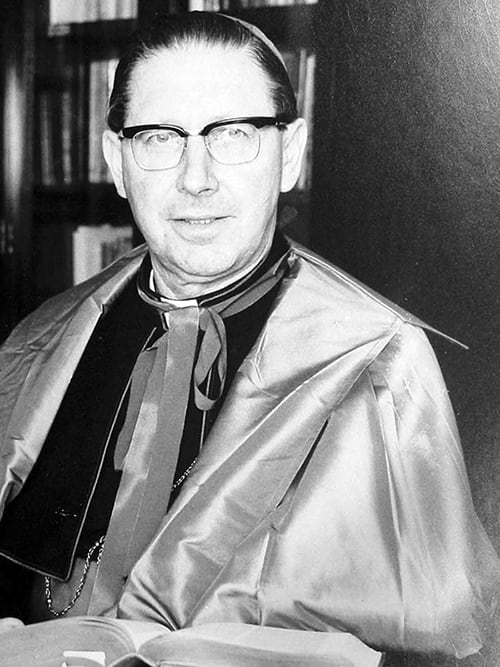 Bishop Bernard Wallace was the first Australian-born Rockhampton Diocesan priest to lead the Rockhampton Diocese. His Episcopal Ordination at St Joseph’s Cathedral, Rockhampton by Archbishop Francis Rush of Brisbane and twenty members of the Australian Episcopal College on 24 April 1974 was the start of a busy episcopate that resulted in the completion of St Joseph’s Cathedral, the establishment of the Centenary Foundation and the successful celebration of the centenary.
Bishop Bernard Wallace was the first Australian-born Rockhampton Diocesan priest to lead the Rockhampton Diocese. His Episcopal Ordination at St Joseph’s Cathedral, Rockhampton by Archbishop Francis Rush of Brisbane and twenty members of the Australian Episcopal College on 24 April 1974 was the start of a busy episcopate that resulted in the completion of St Joseph’s Cathedral, the establishment of the Centenary Foundation and the successful celebration of the centenary.
An accomplished theologian and historian, Bishop Wallace did not stint himself. He was well known to his priests, many of whom were students during his long period as lecturer and Vice-Rector at Banyo Seminary, Brisbane.
Bishop Wallace was born in Melbourne on 21 January 1919, the youngest of the four sons of Michael and Margaret Wallace. Bernard Wallace was educated by the Christian Brothers at East St Kilda from 1925-1932 and at St Kevin’s, Toorak during 1933-34. He was a student for two years with the Columban Fathers at Essendon, Melbourne, and then was accepted for the diocesan priesthood by Bishop Romuald Hayes of Rockhampton in 1937.
The young Bernard Wallace studied philosophy at St Columba’s, Springwood, NSW in 1937-38 and went on to St Patrick’s College, Manly, NSW. In February, 1942, when still a sub-deacon, he received the exceptional appointment to the staff of the then newly-founded Pius XII Seminary, Banyo, Brisbane.
On 26 July 1942, he was ordained a priest by Archbishop Daniel Mannix at Melbourne’s St Patrick’s Cathedral. Earlier in the year he had been raised to the diaconate by Archbishop James Duhig in Brisbane. After ordination Father Wallace returned to Banyo and remained there until the end of 1947. From 1948-52 he did parochial duties at Bundaberg and Mt Morgan. In 1954 the future Bishop returned to Banyo Seminary. In 1963-64 he spent eighteen months in Rome. From 1954 onwards, he remained at Banyo Seminary becoming Vice-Rector in 1968, a post he held until he was ordained Bishop of Rockhampton. He was official observer on the Faith and Order Commission of the Queensland Committee of the Australian Council of Churches.
Bishop Wallace retired as Bishop of the Catholic Diocese of Rockhampton on 4 May 1990 and died on 8 November 1990 after a battle with cancer. His motto “The Truth Will Set You Free” was the theme for his Funeral Liturgy which took place at St Joseph’s Cathedral. On the liturgy booklet Bishop Bernard is quoted as saying, “I was drawn to the priesthood through the missions. In fact, my original desire was to be a missionary rather than a priest. As a boy, I rejected the notion of being a Christian Brother – having ‘no taste for teaching’. Similarly I had left aside the diocesan priesthood because I felt no attraction for parish work. Yet in God’s good time I finished up as a diocesan priest and taught in a seminary for 25 years – and liked it. Surely the Almighty must have his own sense of humour.” Bishop Wallace is buried in the North Rockhampton Cemetery.
Ninth Bishop of Rockhampton – Bishop Brian Heenan (1991-2013)

During his twenty-two years as Bishop of Rockhampton, Bishop Heenan strove to bring alive his motto “Where there is love there is God”. He was the ninth Bishop of the Diocese and the longest serving, his Episcopate covering the years 1991-2013. His Episcopate in Rockhampton Diocese was a time of great change. He continued in the tradition of Bishop Rush and Bishop Wallace before him, and was quick to implement the decisions of the Second Vatican Council in his own Diocese, in particular, to ensure that the voices of all members of the Diocesan family were heard in Diocesan affairs. During this period, due to the diminishing numbers of priests, parishes were put into clusters so that pastoral administration could be carried out more efficiently. A Diocesan Assembly in 2009 was one of many during Bishop Brian’s Episcopate, and saw the development and implementation of a Pastoral Plan for the years 2009-2014. In 2009 he commenced the restoration of St Joseph’s Cathedral to restore it to its original glory and provide a strong foundation for years to come.
Bishop Brian Heenan was born on 4 August 1937 and grew up in Ashgrove, Brisbane. He was educated at the Marist College and from there attended Pius XII Seminary at Banyo.
Bishop Heenan was ordained into the priesthood on 29 June 1962, and served in many parishes, and was the Director of Continuing Education of Clergy in the Archdiocese of Brisbane. He was appointed Bishop of Rockhampton on 23 July 1991 by Pope John Paul II and later that year on 25 September he was ordained by Archbishop Francis Rush.
One of Bishop Heenan’s most obvious gifts is his pastoral nature. His care and concern for one and all was evident in his travels throughout our wide Diocese. The emphasis of Bishop Heenan’s Episcopate, and one which will be his legacy, was to train and educate local communities and empower them into active ministry.
Bishop Brian retired on 1 October 2013.

